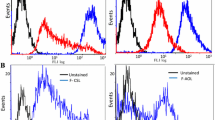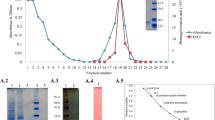Abstract
Physiological role of a core fucose specific lectin from Cephalosporium curvulum isolated from mycotic keratitis patient in mediating pathogenesis was reported earlier. CSL has opposite effects on HCECs, at the initiation of infection when lectin concentration is low, CSL induces proinflammatory response and at higher concentration it inhibits growth as the infection progresses. Here we delineate detailed mechanism of opposing effects of CSL by confirming the binding of CSL and anti TLR 2 and 4 antibodies to TLRs 2 and 4 purified from HCECs using Galectin-3 Sepharose 4B column. Further, the expression of signaling proteins were monitored by Western blotting and apoptosis assay. At concentration of 0.3 µg/ml, CSL induced the activation of TLR-2,-4 and adapter protein MyD88. CSL also induced the expression of transcription factors NFkB, C-Jun and proinflammatory cytokines like interleukins -6 and -8 essential in maintaining cell proliferation. In contrast at higher concentrations i.e. 5 µg/ml CSL induces apoptotic effect as evidenced by increase in early and late apoptotic population as demonstrated by Annexin V-PI assay. Western blotting revealed that CSL treated HCECs at higher concentration lead to MyD88 dependent expression of apoptotic proteins like FADD, Caspase -8 and -3. All these results are in line with and substantiate our earlier results that indeed CSL is involved in mediating host pathogen interactions by interacting with cell surface TLRs, activating downstream signaling pathways leading to pathogenesis. Findings are of clinical significance in developing carbohydrate based therapeutic strategy to control infection and the disease.





Similar content being viewed by others
Data availability
Data will be made availability on reasonable request.
References
Xie, L., Dong, X., Shi, W.: Treatment of fungal keratitis by penetrating keratoplasty. Br. J. Ophthalmol. 85, 1070–1074 (2001)
Klotz, S.A., Penn, C.C., Negvesky, G.J., Butrus, S.I.: Fungal and parasitic infections of the eye. Clin. Microbiol. Rev. 13, 662–685 (2000)
Thomas, P.A.: Fungal infections of the cornea. Eye. 17, 852–862 (2003)
Lis, H., Sharon, N.: Lectins: carbohydrate-specific proteins that mediate cellular recognition. Chem. Rev. 98, 637–674 (1998)
Nagre, N.N., Chachadi, V.B., Eligar, S.M., Shubhada, C., Pujari, R., Shastry, P., Swamy, B.M., Inamdar, S.R.: Purification and characterization of a mitogenic lectin from Cephalosporium, a pathogenic fungus causing mycotic keratitis. Biochem. Res. Int. 2010, 854656 (2010)
Jagadeesh, N., Belur, S., Hegde, P., Kamalanathan, A.S., Swamy, B.M., Inamdar, S.R.: An L-fucose specific lectin from Aspergillus niger isolated from mycotic keratitis patient and its interaction with human pancreatic adenocarcinoma PANC-1 cells. Int. J. Biol. Macromol. 134, 487–497 (2019)
Ballal, S., Belur, S., Laha, P., Roy, S., Swamy, B.M., Inamdar, S.R.: Mitogenic lectins from Cephalosporium curvulum (CSL) and Aspergillus oryzae (AOL) mediate host–pathogen interactions leading to mycotic keratitis. Mol. Cell. Biochem. 434, 209–219 (2017)
Jagadeesh, N., Belur, S., Chachadi, V.B., Roy, S., Inamdar, S.R.: Aspergillus niger lectin elicits MyD88 dependent proliferation and apoptosis at lower and higher doses in immortalized human corneal epithelial cells leading to pathogenesis. Int. J. Biol. Macromol. 165, 2089–2095 (2020)
Inamdar, S.R., Eligar, S.M., Ballal, S., Belur, S., Kalraiya, R.D., Swamy, B.M.: Exquisite specificity of mitogenic lectin from Cephalosporium curvulum to core fucosylated N-glycans. Glycoconj. J. 33, 19–28 (2016)
Belur, S., Jagadeesh, N., Swamy, B.M., Inamdar, S.R.: A core fucose specific lectin from Cephalosporium curvulum induces cellular apoptosis in hepatocellular and pancreatic cancer cells and effective in detecting AFP. Glycoconj. J. 37,1–10 (2020)
Janeway, C.A. Jr., Medzhitov, R.: Innate immune recognition. Annu. Rev. Immunol. 20, 197–216 (2002)
Weber, A.N., Morse, M.A., Gay, N.J.: Four N-linked glycosylation sites in human toll-like receptor 2 cooperate to direct efficient biosynthesis and secretion. J. Biol. Chem. 279, 34589–34594 (2004)
Iijima, J., Kobayashi, S., Kitazume, S., Kizuka, Y., Fujinawa, R., Korekane, H., Shibata, T., Saitoh, S.I., Akashi-Takamura, S., Miyake, K., Miyoshi, E.: Core fucose is critical for CD14-dependent Toll-like receptor 4 signaling. Glycobiology. 27, 1006–1015 (2017)
Arthur, C.M., Rodrigues, L.C., Baruffi, M.D., Sullivan, H.C., Heimburg-Molinaro, J., Smith, D.F., Cummings, R.D., Stowell, S.R.: Examining galectin binding specificity using glycan microarrays. In Galectins, pp. 115–131. Humana Press, New York (2015)
Rabinovich, G.A., Toscano, M.A.: Turning’sweet’on immunity: galectin–glycan interactions in immune tolerance and inflammation. Nat. Rev. Immunol. 9, 338–352 (2009)
Goldman, M.: In fluorescent antibody methods, pp. 101–61. Academic, New York (1968)
Spiro, R.G., Bhoyroo, V.D.: Structure of the O-glycosidically linked carbohydrate units of fetuin. J. Biol. Chem. 249, 5704–5571 (1974)
Akira, S., Takeda, K.: Toll-like receptor signalling. Nat. Rev. Immunol. 4(7), 499–511 (2004)
Zhao, J., Wu, X.Y., Yu, F.S.: Activation of Toll-like receptors 2 and 4 in Aspergillus fumigatus keratitis. Innate Immun. 15, 155 – 68 (2009)
Takeda, K., Kaisho, T., Akira, S.: Toll-like receptors. Annu. Rev. Immunol. 21, 335–376 (2003)
Warner, N., Núñez, G.: MyD88: a critical adaptor protein in innate immunity signal transduction. J. Immunol. 190, 3–4 (2013)
Adachi, O., Kawai, T., Takeda, K., Matsumoto, M., Tsutsui, H., Sakagami, M., Nakanishi, K., Akira, S.: Targeted disruption of the MyD88 gene results in loss of IL-1-and IL-18-mediated function. Immunity 9, 143–150 (1998)
MyD88: a central player in innate immune signaling, https://doi.org/10.12703/P6-97 (2014).
Israel, A.: The IKK complex, a central regulator of NF-kappaB activation. Cold Spring Harb. Perspect. Biol. 2, 000158 (2010)
Lan, W., Petznick, A., Heryati, S., Rifada, M., Tong, L.: Nuclear Factor-κB: central regulator in ocular surface inflammation and diseases. Ocul. Surf. 10, 137–48 (2012)
Karin, M.: The regulation of AP-1 activity by mitogen-activated protein kinases. J. Biol. Chem. 270, 16483–16486 (1995)
Kim, M., Rao, M.V., Tweardy, D.J., Prakash, M., Galili, U., Gorelik, E.: Lectin-induced apoptosis of tumour cells. Glycobiology 3, 447–453 (1993)
Choi, K.B., Wong, F., Harlan, J.M., Chaudhary, P.M., Hood, L., Karsan, A.: Lipopolysaccharide mediates endothelial apoptosis by a FADD-dependent pathway. J. Biol. Chem. 273, 20185–20188 (1998)
Aliprantis, A.O., Yang, R.B., Weiss, D.S., Godowski, P., Zychlinsky, A.: The apoptotic signaling pathway activated by Toll-like receptor‐2. EMBO J. 19, 3325–3336 (2000)
Acknowledgements
SRI thanks the Council of Scientific & Industrial Research (CSIR, No. 27 (0350)/19/EMR-II dated 17th May 2019) and N Jagadeesh thanks the CSIR for fellowship under CSIR-SRF (No. 09/101(0056)/2019/EMR-I).
Author information
Authors and Affiliations
Corresponding author
Ethics declarations
Conflict of interest
Authors declare no conflict of interest.
Ethical approval
This article does not contain any studies with human participants or animals performed by any of the authors.
Additional information
Publisher’s Note
Springer Nature remains neutral with regard to jurisdictional claims in published maps and institutional affiliations.
Rights and permissions
About this article
Cite this article
Jagadeesh, N., Belur, S., Ballal, S. et al. Cephalosporium curvulum lectin causes mycotic keratitis by initiating infection through MyD88 dependent cellular proliferation and apoptosis in human corneal epithelial cells. Glycoconj J 38, 509–516 (2021). https://doi.org/10.1007/s10719-021-10004-0
Received:
Revised:
Accepted:
Published:
Issue Date:
DOI: https://doi.org/10.1007/s10719-021-10004-0




